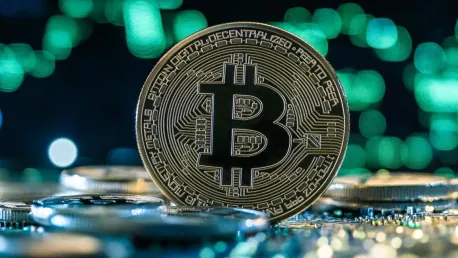The comparison between Bitcoin and gold has gained traction, with many individuals and institutions alike contemplating Bitcoin as the “digital gold.” This analogy posits Bitcoin as a store of value and a safe haven investment. However, the validity and implications of this comparison demand scrutiny, especially when viewed through the lens of past financial crises.
The Rising Popularity of Bitcoin-Gold Analogy
Growing Acceptance and Appeal
Bitcoin enthusiasts often tout the cryptocurrency as the modern equivalent of gold. Its decentralized nature and finite supply are central to the analogy, suggesting Bitcoin may offer protection against inflation and economic instability. As Bitcoin’s market value continues to rise, it appeals to both individual investors and large institutions looking to diversify their portfolios. This growing acceptance has been accompanied by a proliferation of Bitcoin-related financial products, further solidifying its position as a mainstream investment option.
The allure of Bitcoin as digital gold is partly rooted in its limited supply, capped at 21 million coins, which instills a sense of scarcity similar to that of gold. This scarcity, coupled with increasing demand, has contributed to a narrative that Bitcoin can serve as a hedge against traditional economic risks. Proponents argue that as fiat currencies devalue due to inflation, Bitcoin’s limited supply will preserve its value, much like gold has historically done during economic downturns.
Parallels to Historical Financial Trends
The belief in Bitcoin as digital gold reflects historical patterns seen before financial meltdowns. For instance, the widespread trust in mortgage-backed securities (MBS) as safe investments prior to the 2008 crisis offers a cautionary tale on the risks of over-reliance on analogies. The analogy between Bitcoin and gold raises concerns that investors might overlook inherent risks, just as they did with MBS. This similarity underscores the importance of critical scrutiny and the need to avoid complacency when assessing the safety and long-term viability of such investments.
The 2008 financial crisis was precipitated by misplaced confidence in complex financial products, and the analogy of Bitcoin to gold could similarly mask underlying risks. The lessons learned from MBS highlight the danger of assuming that new financial instruments can be understood and trusted based on surface-level similarities to established assets. Investors must remain vigilant and ensure that their understanding of Bitcoin’s characteristics and potential risks is comprehensive and grounded in thorough analysis.
Distinct Differences Between Bitcoin and Gold
Intrinsic Value and Tangible Assets
Gold has intrinsic physical properties and tangible value across various sectors including jewelry, electronics, and medicine. Its diverse applications make it a valuable commodity with uses beyond investment, providing a fundamental underpinning to its value. This intrinsic value has allowed gold to maintain its status as a stable store of wealth throughout history, making it a reliable asset during times of economic uncertainty.
In contrast, Bitcoin lacks any physical utility, deriving its value purely from digital scarcity and market demand. Unlike gold, which holds intrinsic value regardless of market sentiments, Bitcoin’s worth is determined by the consensus of its users and the willingness of investors to buy and hold it. This difference in valuation basis introduces a layer of volatility and unpredictability that is not present with gold. While Bitcoin’s finite supply may suggest scarcity, it does not offer the same tangible benefits that bolster gold’s value.
Resilience and Risk Transparency
Gold’s value is easily ascertainable through simple and consistent testing methods, contributing to its stability. Gold can be physically examined and verified, adding a layer of assurance for investors. Its long history as a safe haven asset further cements its credibility as a reliable store of value during financial crises. This transparency in value assessment stands in stark contrast to Bitcoin, which relies on digital infrastructure to maintain its integrity.
Bitcoin, however, depends on a digital infrastructure that poses potential risks, such as the impact of significant technological failures like power grid collapses. The decentralized nature of Bitcoin requires a functioning internet and power grid, both of which are susceptible to disruptions. This dependency on technology introduces vulnerabilities that do not affect gold, whose value remains stable regardless of technological advancements or failures. Additionally, Bitcoin’s valuation is less transparent, with its price influenced by market speculation, regulatory developments, and other external factors.
Issues of Transparency and Ownership
Blockchain and Ownership Clarity
Bitcoin operates on blockchain technology, creating a public ledger of transactions. While this ledger records all Bitcoin transactions, it does not provide a clear picture of individual ownership patterns or the distribution of holdings. This represents a significant gap in transparency, as true understanding of ownership concentration is crucial for assessing the overall stability and risk profile of the asset. The anonymity provided by blockchain technology can obscure who holds large amounts of Bitcoin, potentially masking systemic risks associated with concentrated ownership.
This lack of ownership clarity is reminiscent of the opacity seen with MBS leading up to the 2008 crisis. Investors assumed safety in MBS based on their perceived structure, unaware of the hidden risks and complexities within. The blockchain ledger can provide some assurance of transaction validity but does not eliminate the need for greater transparency in ownership. Anonymity may offer privacy benefits, but it also perpetuates questions about who controls significant portions of the asset, potentially leading to unforeseen systemic risks.
Speculative Trading and Long-term Value
The speculative nature of Bitcoin attracts traders who may lack the expertise to ascertain its long-term value prospects. Many investors approach Bitcoin with a short-term perspective, driven by the potential for quick gains rather than a comprehensive understanding of the asset’s long-term viability. This speculative approach can lead to significant price volatility and systemic risks, as inexperienced traders may not fully grasp the implications of their investments.
Speculation introduces systemic risks akin to those observed with MBS pre-2008, where hidden risks became disastrous. The rapid rise in Bitcoin’s value can draw investors into a frenzy, inflating prices and creating a bubble. This environment amplifies the probability of abrupt market corrections, with those unprepared for such volatility bearing the brunt. Long-term stability and value assessment require informed and critical evaluation, skills that many speculative traders may not possess, making them vulnerable to market dynamics they do not fully understand.
Institutional Investment Trends
Institutional Embrace and Regulatory Climate
Institutional investors, including pension funds, have been increasingly drawn to Bitcoin, propelled by its rising market value and friendly regulatory environments. The appeal of high returns and a diversified portfolio motivates these institutions to explore Bitcoin as an alternative investment. As regulatory frameworks evolve to accommodate the growing interest in cryptocurrencies, more institutions are considered legitimate participants in the Bitcoin market.
This pattern mirrors the pre-crisis rush to invest in MBS without a full understanding of the risks involved. Like the institutions that eagerly embraced MBS, believing them to be safe and profitable, today’s institutional investors might be led by similar motivations and a quest for returns. However, this could expose them to the same pitfalls experienced during the 2008 crisis if the actual risks are not comprehensively assessed. Robust risk management strategies are necessary to navigate the complexities and uncertainties inherent in cryptocurrency investments.
Potential Repercussions of Regulated Investments
Investing heavily in Bitcoin without comprehensive risk analysis could bring about unforeseen consequences similar to those of the financial crisis. Many institutions that venture into Bitcoin may lack a thorough understanding of its volatility, regulatory uncertainties, and technological dependencies. The drive for high returns should not overshadow the need for a balanced and well-informed investment approach.
The lack of real assets backing Bitcoin, compared to property-collateralized MBS, compounds potential risks. While MBS had underlying assets, albeit with risks, Bitcoin’s value is not supported by physical assets. This distinction makes Bitcoin inherently more speculative, and any significant market downturn could have pronounced effects on investors, including institutional ones. History has shown the importance of in-depth risk evaluation and diversification, principles that remain vital for institutions engaging with cryptocurrencies.
Lessons from Financial History
Drawing Parallels to 2008 Crisis
The 2008 financial crisis emerged from the misplaced trust in MBS as safe investments. The perceived safety of MBS led to widespread adoption, masking the true risks and igniting a financial catastrophe. A similar reliance on the Bitcoin-to-gold analogy could conceal significant risks, emphasizing the need for critical evaluation and caution. Understanding the true nature of an investment requires moving beyond surface-level comparisons and delving into the structural and functional intricacies that define its behavior in different economic conditions.
Advocacy for Critical Examination
The comparison between Bitcoin and gold has gained considerable attention, with both individuals and institutions considering Bitcoin as the “digital gold.” This analogy positions Bitcoin as a store of value and a safe haven investment, similar to how gold has been perceived throughout history. However, the legitimacy and implications of likening Bitcoin to gold warrant thorough examination, especially when considering past financial crises. Bitcoin’s relatively short history and its volatility raise questions about its capacity to serve as a stable store of value. Meanwhile, gold has been esteemed for centuries for its tangible attributes and enduring value during economic turmoil. While Bitcoin’s digital nature and potential for high returns attract attention, some argue it’s speculative and lacks the historical grounding that gold possesses. Thus, assessing Bitcoin as digital gold requires a nuanced understanding of both assets, particularly in the context of global financial instability.









